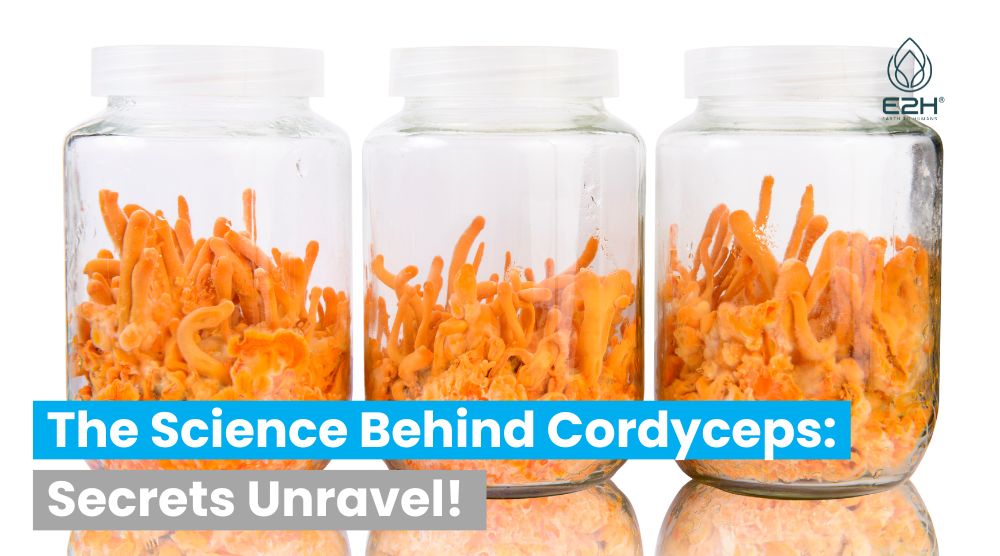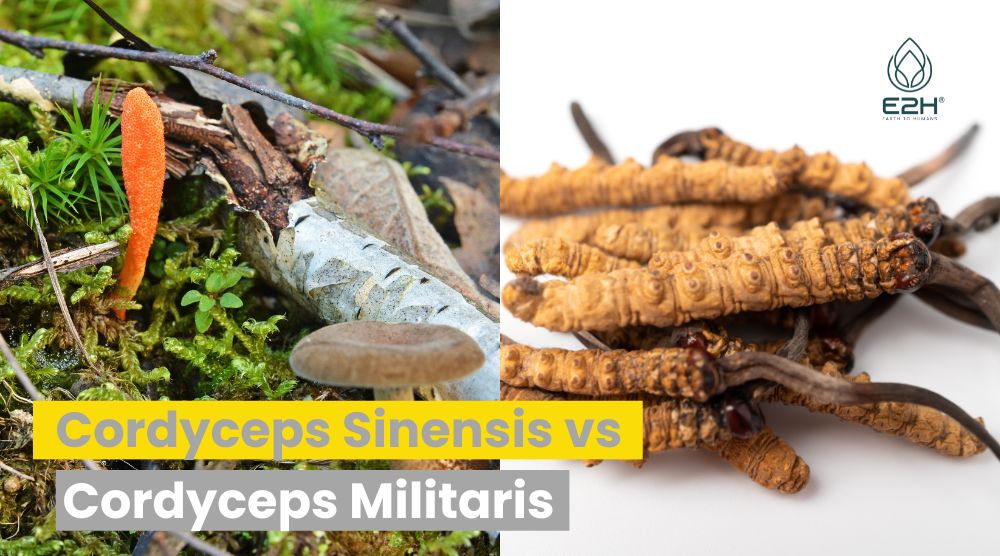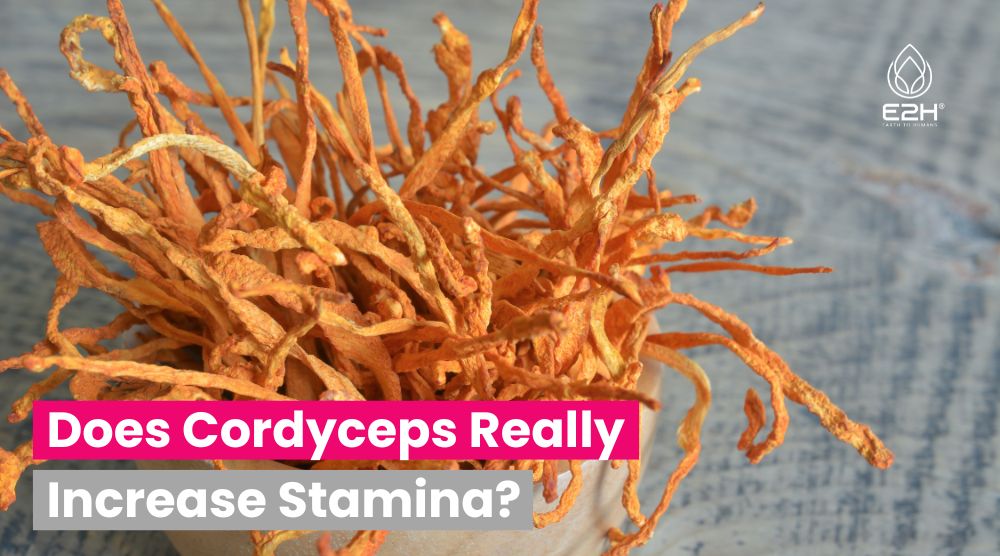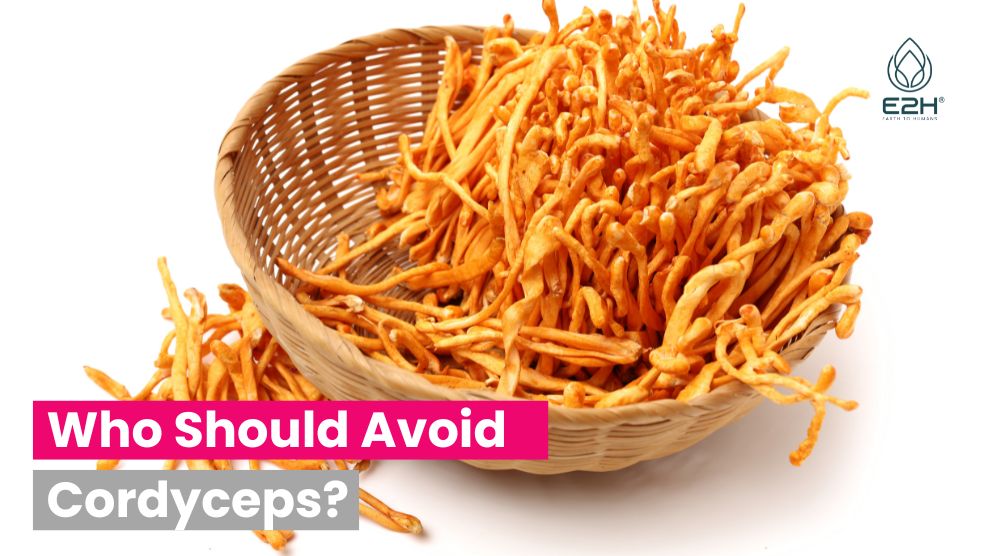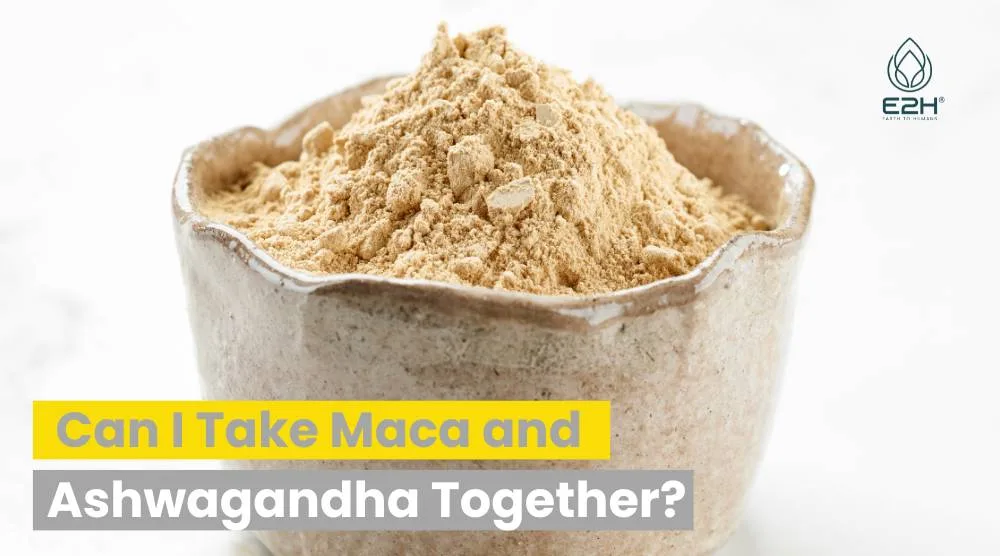The science behind Cordyceps explores its unique parasitic lifecycle, traditional medicinal uses, and investigates its purported health benefits through various research studies.
Cordyceps offers a blend of mystery, science, and potential health promises that beckon further exploration. Join us as we explore the scientific wonders and secrets nestled within the life and applications of this remarkable fungus.
The Science Behind Cordyceps: A Deep Dive
1. Biology and Lifecycle of Cordyceps
Cordyceps is renowned for its parasitic nature, particularly towards insects. The lifecycle of Cordyceps, especially species like Cordyceps Sinensis and Cordyceps Militaris, involves infecting their specific insect hosts, such as ghost moth larvae or carpenter ants, and gradually taking over their fruiting bodies themselves.

The fungus sends mycelia through the host’s body, absorbing nutrients, and eventually leading to the host’s death. Post-mortem, a fruiting body erupts from the insect, releasing spores to perpetuate the lifecycle.
2. Types of Cordyceps
Cordyceps Sinensis
- Habitat: High altitudes in the Himalayan regions.
- Host: Ghost moth larvae.
- Usage: Traditional Chinese medicine for its potential health benefits.
- Scarcity: Wild C. Sinensis is rare and expensive due to over-harvesting.
Cordyceps Militaris
- Cultivation: Can be lab-grown, using rice as a substrate, making it more accessible and affordable.
- Similarities with C. Sinensis: Shares compositional similarities and is considered a viable alternative.
- Consumption: Studies recommend cooking before consumption to avoid potential gastrointestinal issues.
3. Potential Health Benefits and Scientific Scrutiny
Anti-inflammatory Properties
- Cordycepin: A bioactive component in Cordyceps that may help with inflammation related to various health conditions.
- Application: Potential use in managing conditions like asthma, rheumatoid arthritis, and more.
Exercise Performance
- Studies: Some studies indicate improved VO2 max and aerobic performance with Cordyceps consumption, though results vary.
- Mechanism: The potential reduction of inflammation during exercise might enhance performance.
Anti-aging and Libido
- Traditional Beliefs: Cordyceps, especially C. Sinensis, is believed to possess anti-aging properties and enhance libido.
- Scientific Validation: More research is needed to validate these claims scientifically.
Anti-cancer Effects
- Preliminary Findings: Some studies suggest potential anti-cancer activity, but comprehensive research, especially in human trials, is needed.
- Caution: Any consideration of Cordyceps in cancer management should be discussed with an oncologist.
Blood Sugar Regulation
- Lab Studies: Indicate potential benefits in blood sugar reduction and insulin resistance improvement.
- Human Trials: Comprehensive human trials are needed to validate these findings.
4. Cautions and Side Effects
While the Cordyceps supplement has been consumed for centuries, potential side effects, especially in specific populations (e.g., those with Type 2 diabetes or on blood thinners), warrant caution. Gastrointestinal issues, potential interactions with medications, and impacts on autoimmune disorders are aspects to be mindful of. Moreover, the FDA does not regulate supplements, so the consistency and purity of Cordyceps in supplemental forms can vary.
What are the active compounds in Cordyceps that make it beneficial?
Cordyceps is rich in various bioactive compounds that contribute to its reputed benefits. One notable compound is cordycepin, which has been associated with potential anti-inflammatory properties and is being investigated for its capabilities in managing conditions like asthma and arthritis.
Additionally, Cordyceps contains a variety of polysaccharides, which have been linked to potential anti-cancer and immunomodulatory effects.
Moreover, it possesses adenosine, a nucleoside that plays a pivotal role in cellular energy transfer. These compounds, among others, are the focus of research exploring the medicinal and health-promoting properties of Cordyceps.
How does Cordyceps affect the human body at a molecular level?
At a molecular level, Cordyceps influences various physiological processes. The compound cordycepin is believed to modulate inflammatory pathways, potentially mitigating inflammatory responses within the body.
Furthermore, certain polysaccharides in Cordyceps may interact with immune cells, potentially modulating immune responses. Some studies also suggest that Cordyceps can influence cellular energy metabolism, particularly through its adenosine content, which may impact ATP production and utilization.
However, it’s crucial to note that while these mechanisms have been explored in various studies, comprehensive research, especially in human trials, is necessary to fully understand the molecular impact of Cordyceps.
Are there different species of Cordyceps, and do they have varying effects?
Yes, there are over 750 identified species of Cordyceps, each exhibiting unique characteristics and host specificities. For instance, Cordyceps Sinensis is renowned in traditional Chinese medicine and is believed to possess various health benefits, such as enhancing libido and providing anti-aging effects.
Cordyceps Militaris, which can be lab-grown, is often used as a more accessible alternative to C. Sinensis and has been studied for similar health-promoting properties.
Ophiocordyceps Unilateralis, known for infecting ants, has gained attention due to its peculiar lifecycle and influence on host behavior. Different species may contain varying concentrations of bioactive compounds, potentially offering diverse effects and benefits.
What scientific studies have been conducted on Cordyceps?
Numerous studies have explored Cordyceps, focusing on its bioactive compounds and potential health benefits. Research has delved into its anti-inflammatory, anti-oxidant, and anti-tumor properties, often utilizing both in vitro and animal models.
For instance, studies have investigated its impact on exercise performance, revealing potential enhancements in VO2 max and aerobic capacity. Additionally, research has explored its potential anti-diabetic properties, examining its effects on blood sugar levels and insulin sensitivity.
While a plethora of studies exists, it is crucial to note that more comprehensive research, particularly human trials, is needed to validate and understand the full spectrum of Cordyceps’ effects.
Is there evidence supporting the claimed health benefits of Cordyceps?
While Cordyceps has been traditionally used for various health purposes, scientific validation of its benefits is ongoing. Some studies indicate potential benefits, such as improved exercise performance and anti-inflammatory effects, attributed to compounds like cordycepin and polysaccharides. However, results have been mixed and sometimes inconclusive.

For instance, while some studies suggest improved aerobic performance, others do not observe a significant impact. Thus, while preliminary findings are promising and align with traditional uses, more rigorous, well-designed, and peer-reviewed studies are essential to substantiate the claimed health benefits of Cordyceps.
Can Cordyceps help with respiratory conditions, and if so, how?
Cordyceps has been explored for its potential benefits in managing respiratory conditions, particularly due to its purported anti-inflammatory properties. Some studies suggest that cordycepin, a notable compound in Cordyceps, may help mitigate inflammatory responses within the respiratory tract, which could potentially aid conditions like asthma.
Additionally, traditional uses have included treating coughs and respiratory disorders. However, while these traditional uses and preliminary studies provide a basis for potential applications in respiratory health, comprehensive research and clinical trials are necessary to validate these effects and understand the mechanisms through which Cordyceps might impact respiratory conditions.
How does Cordyceps influence energy metabolism and stamina?
Cordyceps is believed to influence energy metabolism and stamina through various mechanisms. The fungus contains adenosine, a nucleoside that is pivotal in energy transfer and regulation within cells, potentially impacting ATP production and utilization.
Some studies suggest that Cordyceps may enhance mitochondrial function, thereby improving cellular energy production and efficiency. Additionally, it has been traditionally used to combat fatigue and enhance physical performance.
Some research indicates potential improvements in exercise performance and reduced muscle fatigue with Cordyceps supplementation, though results have varied, and mechanisms are still being explored.
Are there clinical trials investigating Cordyceps’ efficacy?
Yes, various clinical trials have been conducted to explore the efficacy of Cordyceps in different health aspects. These trials have investigated its potential impact on exercise performance, immune modulation, and anti-inflammatory effects, among others.
Some trials have indicated potential benefits, such as improved aerobic capacity and reduced chronic inflammation in, while others have yielded inconclusive results. It’s crucial to note that while some findings are promising, further well-designed, randomized, and peer-reviewed clinical trials are necessary to substantiate these findings and establish Cordyceps’ efficacy in various health applications.
What is the recommended dosage of Cordyceps based on scientific findings?
The recommended dosage of Cordyceps can vary based on the specific supplement, its form, and the purpose of use. Some studies have utilized dosages ranging from 1 to 3 grams per day for specific purposes, such as enhancing exercise performance.
However, it’s crucial to note that a standardized cordyceps dosage amount has not been established due to variability in supplement formulation and the lack of comprehensive research defining optimal dosages for various applications. Therefore, it is advisable to adhere to supplement-specific guidelines and consult healthcare professionals before incorporating any Cordyceps supplements into your regimen to ensure safe and effective use.
Are there any interactions between Cordyceps and medications?
Yes, Cordyceps can interact with certain medications, warranting caution and consultation with healthcare professionals before use. For instance, due to its potential impact on blood sugar levels, Cordyceps might interact with anti-diabetic medications, potentially enhancing their effects and risking hypoglycemia.
Additionally, Cordyceps may possess anti-coagulant properties, which could interact with blood thinners, enhancing their effects and increasing bleeding risks.
Furthermore, its potential immunomodulatory effects might interact with immunosuppressive medications. Therefore, individuals on medications, particularly for diabetes, blood clotting, or autoimmune conditions, should exercise caution and consult healthcare professionals before using Cordyceps.
Where can I find reputable sources for scientific articles on Cordyceps?
For scientific articles on Cordyceps, consider exploring databases and platforms that provide access to peer-reviewed journals and publications. Some reputable sources include:
- PubMed: A widely-used database for biomedical literature.
- Google Scholar: A freely accessible search engine that indexes scholarly articles across various disciplines.
- ScienceDirect: A platform offering access to scientific and technical research.
- Wiley Online Library: Provides access to a broad range of scientific publications.
- Springer: Offers access to scientific documents, books, and articles.
How does Cordyceps Sinensis infect its insect host?
Cordyceps Sinensis infects its insect host, typically the ghost moth larvae, through a fascinating and somewhat macabre process. The fungus releases its spores, which, upon contact with the insect, germinate and penetrate its exoskeleton.

Once inside, the fungal mycelia spread throughout the host’s body, consuming it from the inside, and eventually taking control of its bodily functions, often manipulating its behavior to optimize the fungus’s lifecycle. The infected insect is driven to a location favorable for the fungus’s growth before it dies. Post-mortem, the Cordyceps fruiting body emerges from the insect, releasing spores and perpetuating the cycle.
How is C Militaris cultivated in labs?
Cordyceps Militaris is cultivated in laboratories through a meticulous process to ensure optimal growth and bioactive compound production. The process typically involves utilizing a substrate, often a grain like rice, which is inoculated with C. Militaris spores or mycelium. The substrate provides the necessary nutrients for the fungus to grow.
Cultivation occurs in controlled environments where factors like temperature, humidity, and light are regulated to mimic natural conditions and optimize growth. After a period of incubation, during which the mycelium colonizes the substrate, fruiting bodies form, which can then be harvested for use or further spore production.
How does the FDA regulate supplements containing medicinal mushrooms like Cordyceps?
The FDA regulates dietary supplements, including those containing Cordyceps, under the Dietary Supplement Health and Education Act (DSHEA) of 1994. Unlike pharmaceuticals, supplements do not require FDA approval before being marketed.
Manufacturers are responsible for ensuring their products are safe and accurately labeled. However, the FDA can take action against supplements found to be unsafe or mislabeled once they are on the market.
Additionally, claims made by supplement manufacturers regarding health benefits must be accompanied by a disclaimer that the FDA has not evaluated the claim and that the product is not intended to diagnose, treat, cure, or prevent any disease.
What research exists regarding the anti-cancer effects of Cordyceps?
Research on the anti-cancer effects of Cordyceps has primarily been conducted in vitro and in animal models. Studies have explored the impact of Cordyceps on various cancer cell lines, observing potential anti-proliferative, anti-metastatic, and apoptosis-inducing effects.
Some research suggests that bioactive compounds in Cordyceps, such as cordycepin and polysaccharides, may play a role in these anti-cancer activities by modulating immune responses and interfering with cancer cell signaling pathways.
However, while these preliminary findings are promising, comprehensive research, particularly in human clinical trials, is necessary to substantiate these effects and understand the potential role of Cordyceps in cancer management or prevention.
FAQs
What are the primary habitats of Cordyceps fungi?
Cordyceps fungi predominantly inhabit various regions in Asia, particularly in high-altitude areas of the Himalayas and other mountainous terrains.
How does Cordyceps enhance its own proliferation through host manipulation?
Cordyceps manipulates host behavior, driving them to locations optimal for fungal spore dispersal, ensuring the fungus’s lifecycle continues post-host death.
Are there any potential risks or side effects associated with consuming Cordyceps?
Yes, potential risks include gastrointestinal issues, and individuals with certain conditions or on specific medications should exercise caution.
What role does Cordyceps play in traditional Chinese medicine?
Cordyceps is utilized in traditional Chinese medicine for purported benefits like enhancing vitality, managing fatigue, and supporting respiratory health.
How does Cordyceps militaris differ from Cordyceps sinensis in terms of cultivation?
Cordyceps militaris can be lab-cultivated on various substrates like rice, making it more accessible and sustainable compared to wild-harvested Cordyceps sinensis.
Conclusion
Exploring the science behind Cordyceps opens a window into a fascinating intersection of biology, traditional medicine, and emerging research. From its captivating lifecycle to its potential health applications, Cordyceps continues to be a subject of vital research and boundless curiosity.
As we continue to explore its mysteries and validate its benefits, Cordyceps stands as a testament to the wonders and potentialities hidden within the natural world, awaiting our discovery and understanding. May the journey of learning and exploration continue, bringing forth new knowledge and applications for us throughout the day and future.
